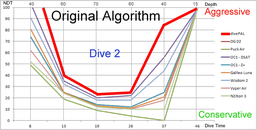DazedAndConfuzed
Contributor
Hi,
I have a Mares computer that uses the more conversative Wienke RGBM algorithm and a backup Aeris that uses the more liberal Modified Haldanean algorithm. In almost all the cases, I would see less NDL time on the Mares computer, but in one situation on my trip, I looked at the Aeris and saw the deco stop sign displayed (to be fair, on another dive, the Mares beeped and told me to do a deco stop too). I knew it couldn't be a fluke since only a day or two ago, my wife who uses an Aeris told me she saw this extra thick bar at the nitrogen loading graph, which never having seen that on my recently recommissioned Aeris, thought she was seeing things. On that dive, neither of my dive computers went into deco mode.
I use to dive with just one computer, but dug the old one out just to use it as backup. Plus, much of the dives we stayed deep for relatively long, where in many places, going deeper just meant seeing the same thing, only darker and bluer, this trip, one has to linger in the deep to catch the pelagics.
I have a Mares computer that uses the more conversative Wienke RGBM algorithm and a backup Aeris that uses the more liberal Modified Haldanean algorithm. In almost all the cases, I would see less NDL time on the Mares computer, but in one situation on my trip, I looked at the Aeris and saw the deco stop sign displayed (to be fair, on another dive, the Mares beeped and told me to do a deco stop too). I knew it couldn't be a fluke since only a day or two ago, my wife who uses an Aeris told me she saw this extra thick bar at the nitrogen loading graph, which never having seen that on my recently recommissioned Aeris, thought she was seeing things. On that dive, neither of my dive computers went into deco mode.
I use to dive with just one computer, but dug the old one out just to use it as backup. Plus, much of the dives we stayed deep for relatively long, where in many places, going deeper just meant seeing the same thing, only darker and bluer, this trip, one has to linger in the deep to catch the pelagics.




